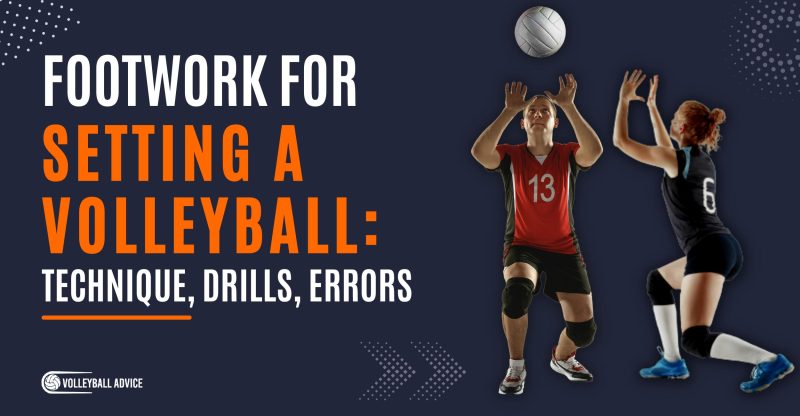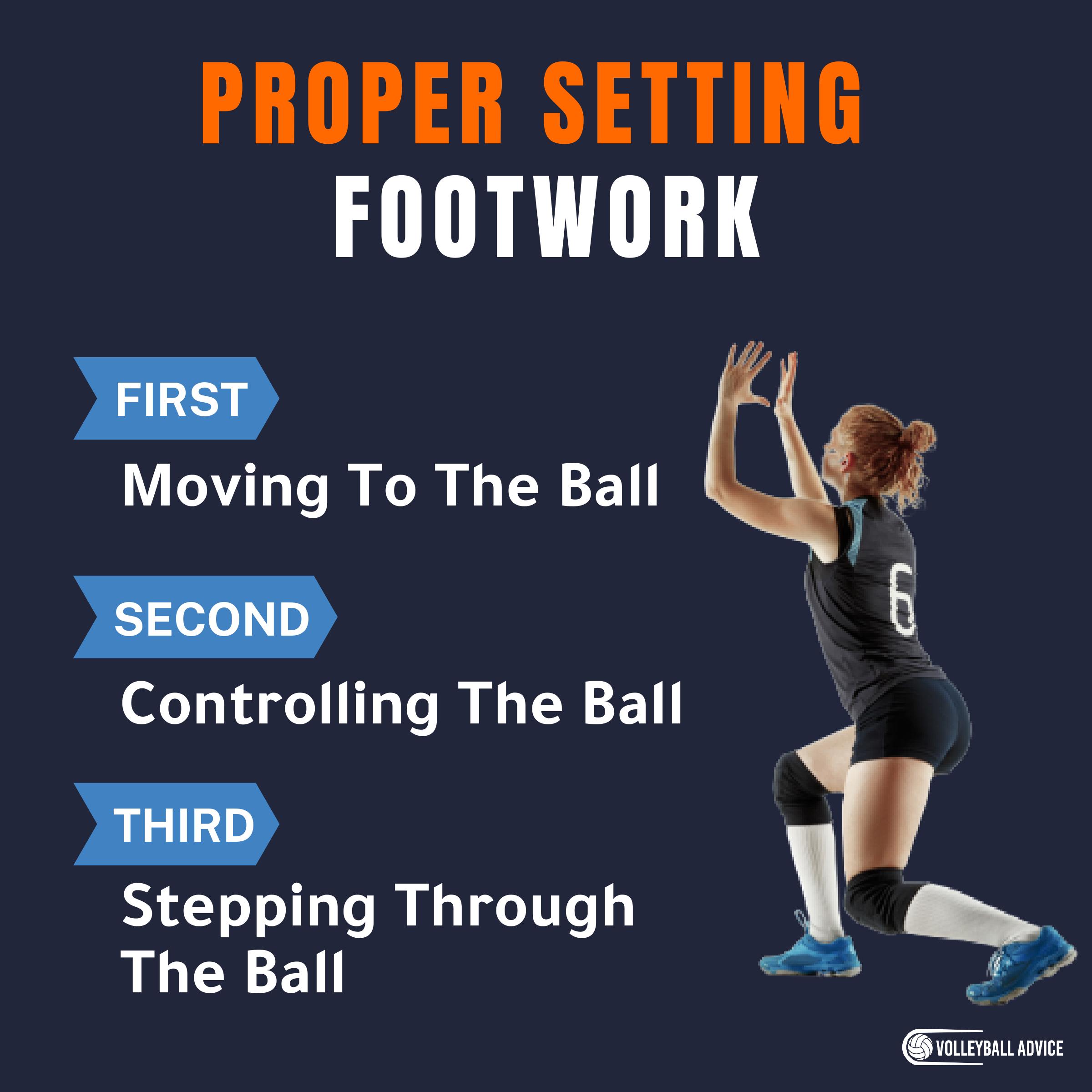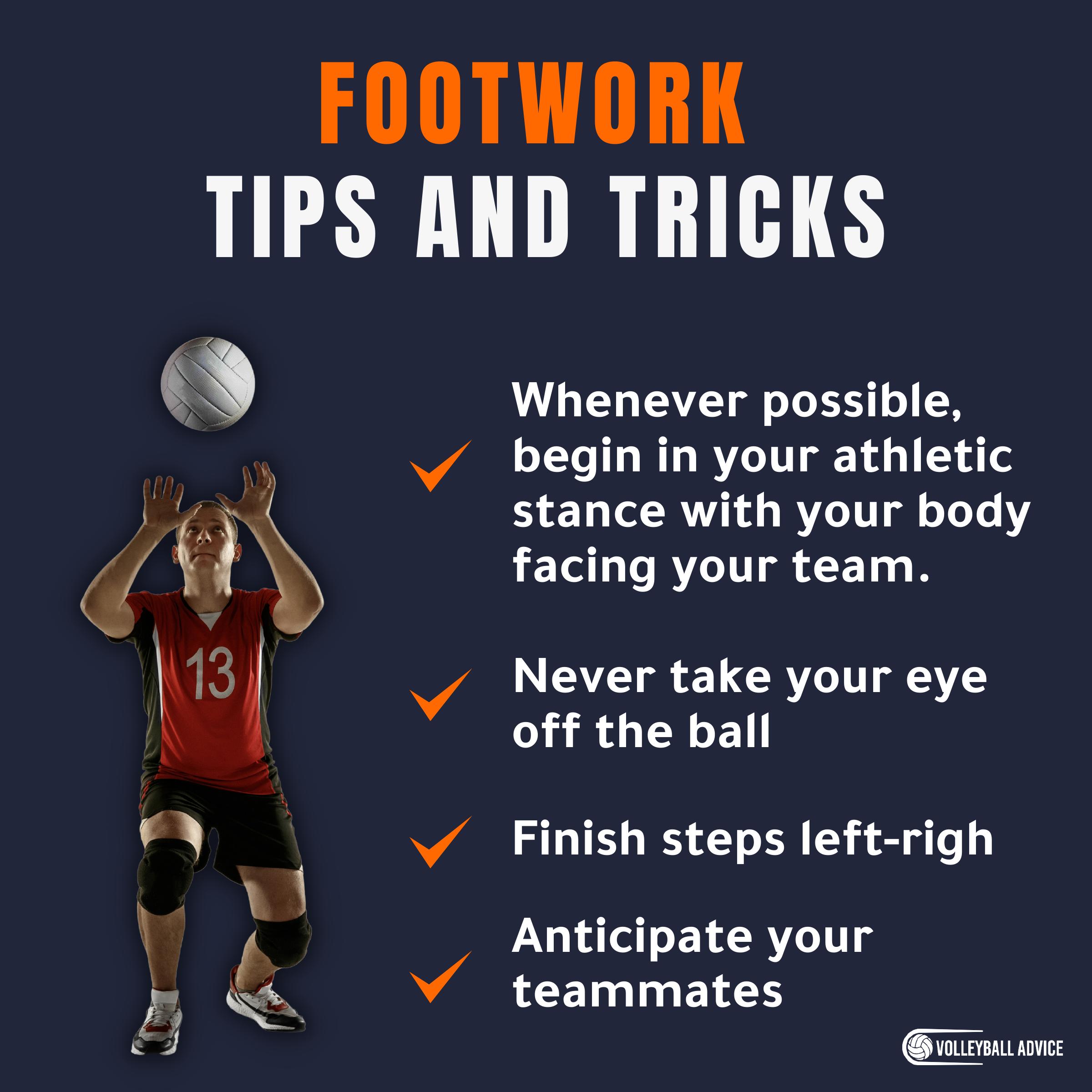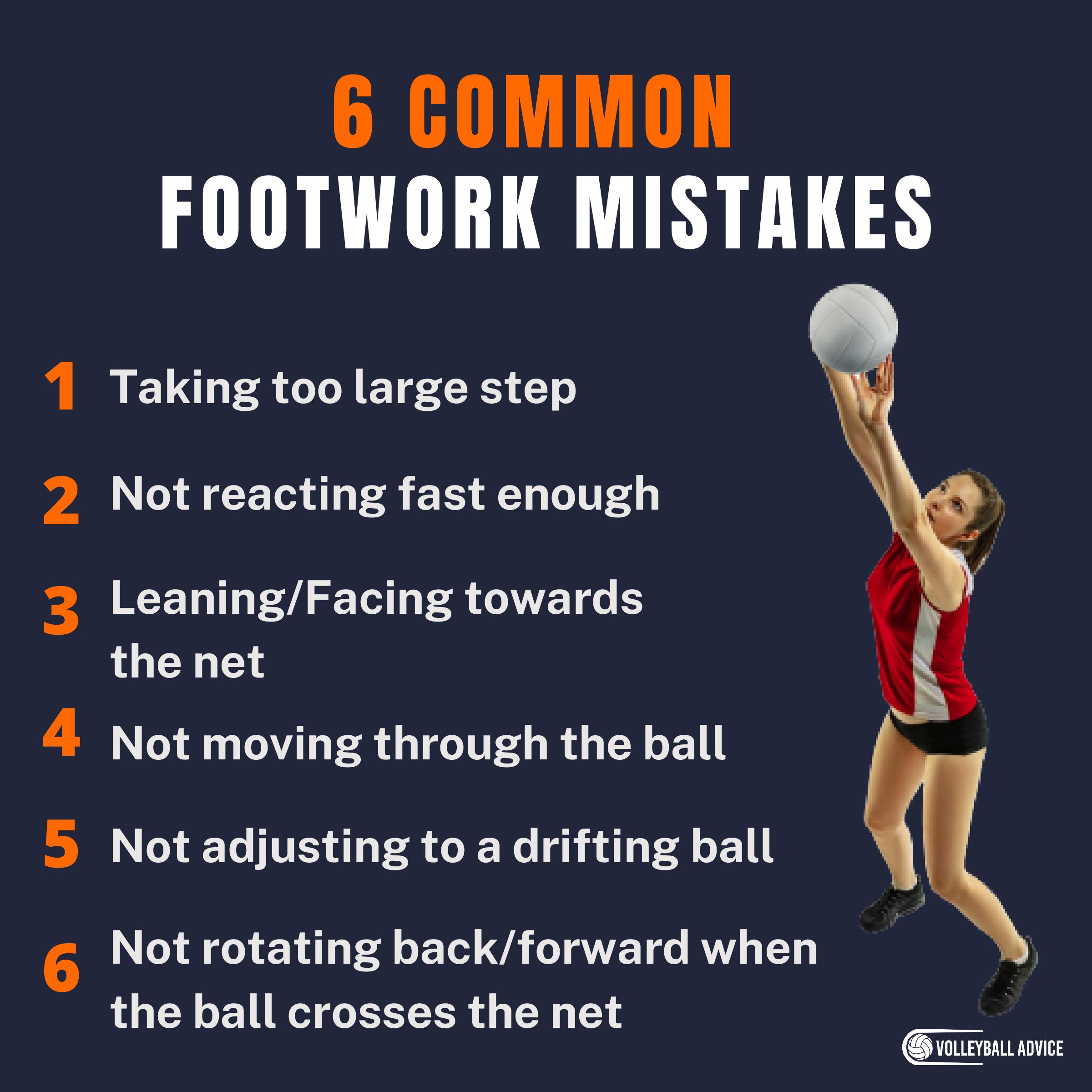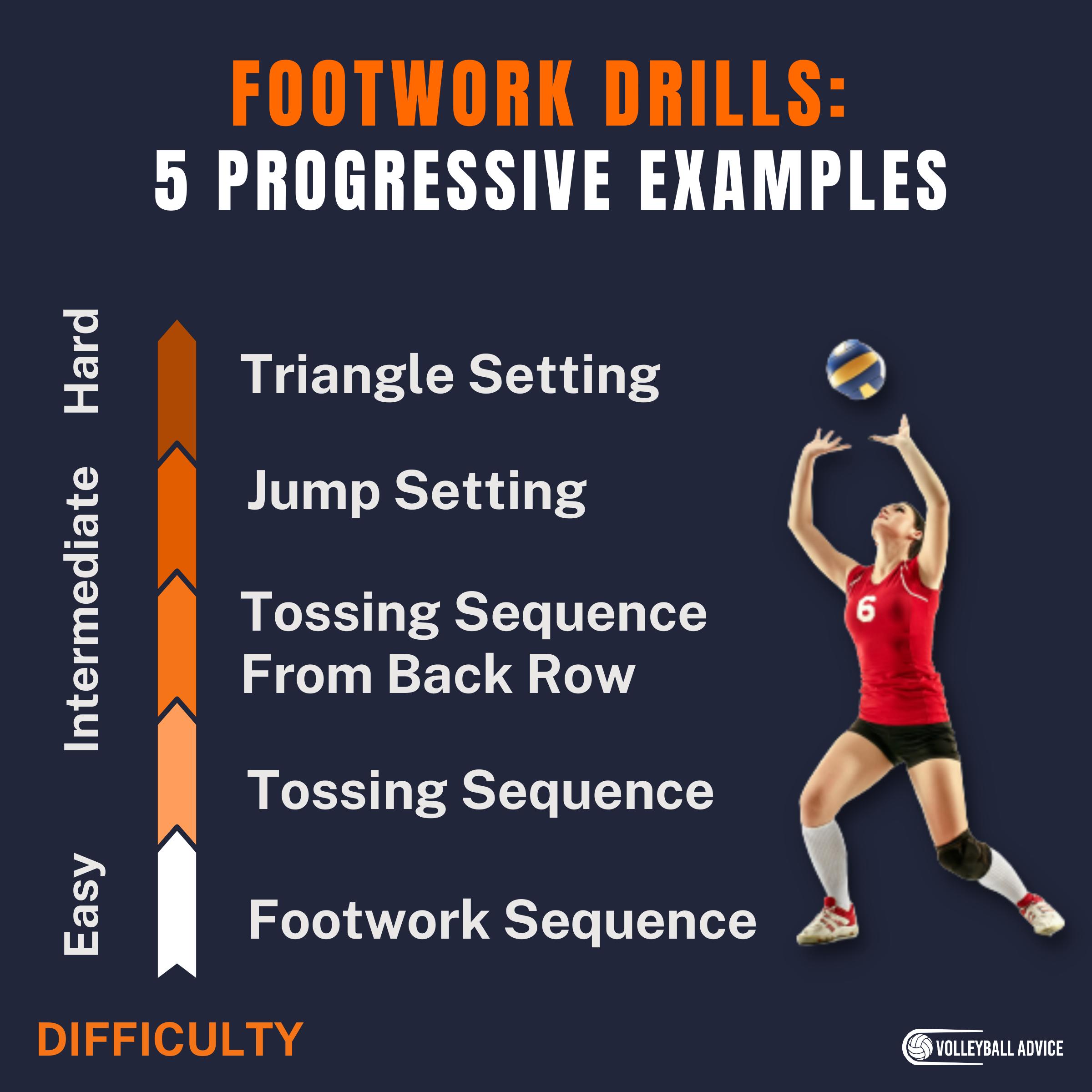Footwork For Setting A Volleyball: Technique, Drills, Errors
Setting is one of the most difficult skills to master in volleyball. However, just like every other skill, it all starts with the footwork.
Setters are quick, light on their feet, and highly adaptable players. The second ball after the pass is always theirs, and if the receive is off the net they have to be able to reach it in time. While footwork for other positions is important, footwork for setting is king.
So, what is the footwork for setting a volleyball? Setting footwork involves the setter moving quickly to reach where the ball will drop, positioning their right foot in front of their left and transferring their weight through the ball. At advanced levels, footwork also includes jump setting, pivot setting, and finishing with their toes pointed towards position four.
By the end of this article, you should be able to:
- Understand why setting footwork is important
- Execute the theory of efficient movement
- Know several common mistakes and how to avoid them
Setting All Begins With Good Footwork
Precision is the mark of a great setter.
This should be your guiding mantra: precise choices, pinpoint placement of the ball for your teammates to spike, and flawless footwork.
It can be easy to overlook the footwork, but that’s where it all begins. Together, these three will bring you success and victory, but they are not easily achieved. It takes practice – hours of practice – but all your effort will yield results.
On the other hand, no one likes a lazy setter.
Those who have poor footwork and rotational skills inevitably end up arriving to the ball late, making poor decisions, and being unable to exercise proper setting hand technique. The ball should drop on top of your forehead every time, and when you are late the ball may have already passed that point, or is off the mark.
It all begins with the footwork, and at the end of the day, all that takes is a little effort. And when you don’t put in the effort – being a lazy setter – it shows. Believe me; nothing is more obvious, and nothing can hold your team back more.
Proper Setting Footwork
Setting footwork includes moving to the ball, setting up to control the ball, and moving through the ball.
Moving To The Ball
Firstly, before the ball reaches the top of its arc, identify where the ball will drop on court and move there.
If your passers have done their job correctly, this will usually be near the net slightly to the left of position two: the right front of the court.
Your steps should be efficient and not too large, allowing for small adjustments and quick acceleration.
Controlling The Ball
Next, you should aim to contact the ball directly above your forehead.
Footwork largely deals with positioning, and knowing where to set up in relation to the ball is incredibly important to developing good, efficient footwork. The best way to learn this is by watching, playing, and practicing. Experience is the best teacher.
To test your positioning, simply allow the ball to bounce off your head instead of setting it:
- If done right, the ball will bounce towards the direction you wish to set.
- If it goes straight up, you’re standing too far forward
- If it ricochets forward or misses your head entirely, you’re too far back.
Your feet should be wide with a distributed balance to allow you to push through the ball. Make sure your toes are pointed towards position four – the left front side of the court – with the foot closest to the net (your right) slightly in front of your left. This will prevent you mentally and physically from accidentally setting the ball across the net, and angle your shoulders slightly towards your team.
Stepping Through The Ball
Lastly, step through the ball as you contact it and push with your legs to give it height.
Remember, volleyball is a sport about moving forward, and that includes setting. Setting should not be a static motion, but active and dynamic.
If done correctly, no matter what position or tempo you choose to set, your setting footwork should look and act the same. While the distance you move will change, the way you cross the court, the positioning of your feet, and the way you move through the ball should be nearly identical each time.
Key Takeaways
The 3 stages of proper footwork are:
- Moving to the ball
- Controlling the ball
- Stepping through the ball
These can be easily seen in action in the following video:
Footwork Tips and Tricks
In addition to the basic tenets of footwork, there are certain things a setter should always focus on. Here are some top tips about setting footwork that should help you level up your game.
-
Whenever Possible, Begin in Your Athletic Stance With Your Body Facing Your Team
This will allow you to make any small adjustments that may be necessary and execute sharp movements as efficiently as possible.
-
Never Take Your Eye off the Ball
This has been said before in every ball sport, but it’s always worth reiterating. Knowing where the ball is going is your business as a setter, and will save precious seconds if you’re scrambling to get in position. Trust that your teammates will move, and return every ascertaining glance to the primary object: the ball.
-
Finish Steps Left-Right
This advice was given to me by my coach, and will help you end your movement in the correct stance to set. Mentally and physically, this streamlines your transition and gives you a clear finish to any movement. These steps should be small and sharp.
-
Anticipate Your Teammates
Setting is a hard enough job without wondering what your teammates are doing, but learning to predict what your team is doing will help massively footwork-wise. Start anticipating where different players pass due to different receives, and move there instead of a set position near the net. This will help you move efficiently and stay effortlessly ahead of the game.
When you compete at high levels of the sport, setters will eventually need to develop advanced setting footwork such as jump setting and single footed turns. These skills essentially build upon skills that you have already practiced, and will take you to the next level of competition readiness.
How Does Footwork Change Based On Different Situations?
The biggest factor that changes for setting footwork is the distance travelled. This may be because of the pass, but it also has to do with whether the setter is starting in the back row or front.
When the setter is in the front row, they are already in the perfect position near position two, where they act as a blocker. It’s a simple matter to turn to their team and step into place to set, but setting from the back row becomes much more involved.
When in the back row, the setter needs to rotate every time the ball crosses the net.
This means running forward to position two, setting to your spikers, and returning to position one at the right back of the court where the setter defends back row. This involves a lot of transitioning, and while it’s tempting to stand in place and watch the outcome of your set, it’s more important to remember to move.
Some challenges of being in the back row are bad rotations that don’t allow you to move freely.
Good servers will target your path and hinder your movement, shutting down your attack before it’s even started. The best way to respond to this is by giving your passers more room to work, even if that means taking a longer route.
No matter what situation arises, changing the nature of the point and making your job more interesting, the most important thing is to be proactive.
Be speedy and efficient in your movement, assess situations and targets as you work, and get to the ball early. The earlier you are there, the more time you have to think and assess the state of the game. And as a setter, the more time you have to think, the more likely you are to win.
Check out this guide: Hand Position For Setting In Volleyball (7 Steps)
Differences In Footwork For Beach Volleyball
As for footwork, the same rules as indoor setting still apply, but the sand makes it harder.
Sand is hard to move in, but it’s important to keep your feet moving. The wind often causes the ball to drift, so setting up early like you do in indoor volleyball doesn’t work as well. You will need to retrain how you predict where the ball will land, and constantly be ready to adjust to set to your partner. Be ready to move more than you think.
Like indoor volleyball, stand sideways to the net while setting on beach. Whether you’re hand setting or bump setting, point your feet towards position four and rise with your legs through the ball to give it height.
Once you’re done setting, transition back to your defending position with your partner and get ready for the next ball. Use proper transitioning form with upper body – lower body separation to keep your eye on the action on court, and return to your athletic stance, ready to defend.
6 Common Footwork Mistakes & How To Correct
1. Taking Too Large Steps
When you take steps that are too large when transitioning to set a volleyball, you lose the ability to accelerate and adjust as easily. This happens naturally for players who do a lot of running, and even the approach jump for spiking uses longer strides.
Mentally check yourself when adjusting to set, and get used to smaller, sharper strides.
2. Not Reacting Fast Enough
A common mistake for rookie setters, this mistake is simply not reacting fast enough.
Instead of watching the ball be passed, fly towards you, or float out of bounds, train yourself to move as soon as possible. This will give you as much time as possible to work, and make your movement as efficient as possible.
3. Leaning/Facing Towards the Net
This mistake is another common one for rookies, and has to do with the setup to control the ball portion of footwork. Oftentimes, new setters are either nervous or inexperienced enough that they face or lean too close to the net. This causes the ball to drift over to the other side as a free ball.
Remember to place your right foot forward and angle your shoulders slightly inside your court to fix this.
4. Not Moving Through the Ball
Not moving forward is one of the biggest problems for technique in volleyball. Setting’s power and height comes from the legs, and while you can rise in place, it is much more effective to move forwards, transferring your momentum to the set.
Allow the ball to drop on your forehead or slightly in front of you, and practice moving through it when you set.
5. Not Adjusting to a Drifting Ball
One of the biggest mistakes that I see rookie setters make, setting up too early and refusing to adjust to a drifting ball leads to a poor set and often a lost point.
To fix this, take little steps when setting up where the ball will drop, and be ready to move as early as you see it falling away from you.
6. Not Rotating Back/Forward When the Ball Crosses the Net
Lastly, this is a mistake that stems from laziness, and is one that I see even veteran setters make. It’s tempting to watch your set and stay in place rather than rotating back and forth constantly, but by doing so you leave a hole in the defense and make your team unfairly cover you.
To solve this, just remember to move, even when that means you can’t see the spike: all that’s needed is a little bit of effort.
Footwork Drills: 5 Progressive Examples
For these drills, they can be performed with targets as players, baskets, or even water bottles. Similarly, the coach can be replaced with another player or friend who is willing to help. Use your creativity, and have fun while you work!
1. Footwork Sequence
- Difficulty: Easy
Have your setter start in serve/receive position in position one (right back) and transition to the net. Pivot at the net with their hands up and eyes on where the ball would be coming from, and feign setting left or right to establish target positions. Hold the setting release form for two seconds, then release.
Repeat with one step off the net and three steps off the net for variation.
2. Tossing Sequence
- Difficulty: Easy
Have your setter stand at the net. The coach will toss them a perfect pass, which they will set left or right to the target. The focus should be on leading with the right foot so that the rest of the body follows. The goal is to set the ball straight with a good line.
Have the coach alternate tosses so that the setter must adjust where they stand. Make the tosses more difficult, and practice setting forward and backwards to target.
3. Tossing Sequence From Back Row
- Difficulty: Intermediate
After the setter becomes familiar and comfortable with the left/right footwork, start the setter from the back-row in serve-receive position. The coach slaps the ball to initiate the setter’s release.
Repeat the same series as the first tossing sequence, but with the setter transitioning to the net instead of starting next to it.
4. Jump Setting
- Difficulty: Intermediate
After the setter becomes comfortable with more movement, add a jump setting series using the same sequence as before. This entire sequence should be done over and over until the footwork is automatic.
The focus of this is moving upwards through the ball, and the setter should seek to set the ball on their way upwards at the height of their jump. Strive for consistency, and work until accuracy is achieved.
5. Triangle Setting
- Difficulty: Hard
Have the setter stand at the net with a target in one or both of the attacking zones – in this case, positions four and two – and toss them a ball to set. The focus should strictly be on the left to right footwork with their right foot finished toward the target at four.
Other Setting Resources
- Types of Sets In Volleyball: 18 Types Explained + How To Use
- How To Set A Volleyball Without Hurting Your Fingers: 5 Tips
- How To Set a Volleyball Without Noise (8 Tips)
- 4 Keys To Being The Best Setter You Can Be
Final Thoughts
Overall, setting footwork is incredibly important to becoming a standout player. Proper footwork includes moving to the ball, setting up to control the ball, and moving through the ball. All three are necessary to succeed.
Laziness is the main opponent to good footwork, and this can be easily solved with a little effort.
My challenge to you, setter, is to do the work. Focus on technique, but don’t forget the footwork. Do the drills, run the ladder, and keep your footwork zippy and clean. Footwork is a foundation, and from the strongest roots grow the highest trees.
Other Footwork Resources
- Footwork For Spiking A Volleyball: How-To, Tips, Drills
- Footwork For Serving A Volleyball: How-To, Tips, Drills
About The Author
![Ailan Samuel]()
Ailan Samuel is a writer and athlete who has played volleyball at the university, club, and national level since 2012. He has competed successfully in both beach and indoor competitions, resulting in four silver and two gold medals, and was awarded the Half-Blue while playing in Scotland. He received his MA in English and Medieval History from the University of St Andrews, Scotland, and is currently studying for his MA in Publishing and Creative Writing at Bournemouth University.

